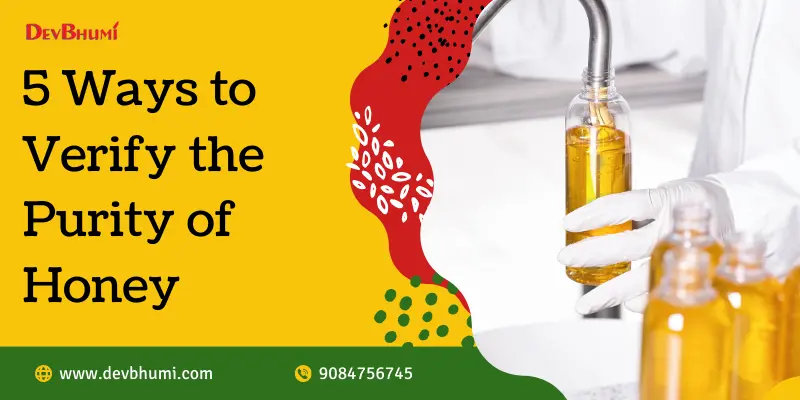
5 Ways to Verify the Purity of Honey
HOW TO IDENTIFY HONEY PURITY TEST AT HOME?
Honey is a natural sweetener that has been used for centuries. It is produced by bees from the nectar of flowers, and it contains a variety of nutrients, including vitamins, minerals, and antioxidants. Honey is known for its many health benefits, such as boosting the immune system, fighting inflammation, and promoting wound healing.
However, not all honey is created equal. Some honey may be adulterated with sugar, water, or other substances. Adulterated honey may not have the same health benefits as pure honey, and it may even be harmful.
There are a few simple tests that you can do at home to check the purity of your honey.
1. Water Dissolving Test
This test is easy to do and requires only a glass of water and a spoonful of honey. Simply add the honey to the water and stir. If the honey dissolves completely, it may be adulterated with water or sugar. Pure honey should settle to the bottom of the glass and form a mound.
2. The Flame Test
This test is a bit more dangerous, so be careful when performing it. To do this test, dip a matchstick in the honey and try to light it. If the honey is pure, the matchstick should light easily. If the honey is adulterated with water or sugar, it will be difficult to light the matchstick.
3. The Thumb Test
To do this test, simply place a drop of honey on your thumb. If the honey drips off easily, it may be adulterated with water. Pure honey will stick to your thumb and form a mound.
4. The Vinegar Test
To do this test, mix a few drops of honey with a tablespoon of vinegar. If the mixture foams, it may be adulterated with corn syrup. Pure honey will not foam when mixed with vinegar.
5. The Honeycomb Test
This test is a bit more difficult to do, but it is the most accurate way to check the purity of your honey. To do this test, you will need a piece of honeycomb. Place a drop of honey on the honeycomb. If the honey spreads out easily, it may be adulterated. Pure honey will form a bead on the honeycomb.
If you perform any of these tests and your honey fails, it is best to discard it. Adulterated honey may not be safe to eat, and it may not have the same health benefits as pure honey.
Here are some additional tips for choosing and storing pure honey:
- Look for honey that is labeled as “raw” or “unfiltered.” This means that the honey has not been heated or processed, which helps to preserve its nutrients.
- Avoid honey that is labeled as “blended” or “processed.” This honey may have been adulterated with other substances.
- Store honey in a cool, dark place. Honey can keep for many years if it is stored properly.
By following these tips, you can choose and store pure honey that you can enjoy for its many health benefits.
Here are some additional information about honey purity test:
- Water Dissolving Test: This test is based on the fact that pure honey is more viscous (thicker) than water. Adulterated honey may contain water or sugar, which will make it less viscous. To perform this test, simply add a spoonful of honey to a glass of water and stir. If the honey dissolves completely, it may be adulterated. Pure honey should settle to the bottom of the glass and form a mound.
- The Flame Test: This test is based on the fact that pure honey is flammable. Adulterated honey may contain water or sugar, which will make it less flammable. To perform this test, dip a matchstick in the honey and try to light it. If the honey is pure, the matchstick should light easily. If the honey is adulterated with water or sugar, it will be difficult to light the matchstick.
- The Thumb Test: This test is based on the fact that pure honey is sticky. Adulterated honey may contain water or sugar, which will make it less sticky. To perform this test, simply place a drop of honey on your thumb. If the honey drips off easily, it may be adulterated with water. Pure honey will stick to your thumb and form a mound.
- The Vinegar Test: This test is based on the fact that pure honey does not react with vinegar. Adulterated honey may contain corn syrup, which will react with vinegar and form a foam. To perform this test, mix a few drops of honey with a tablespoon of vinegar. If the mixture foams, it may be adulterated with corn syrup. Pure honey will not foam when mixed with vinegar.
- The Honeycomb Test: This test is based on the fact that pure honey will form a bead on honeycomb. Adulterated honey may contain water or sugar, which will make it spread out on the honeycomb. To perform this test, place a drop of honey on a piece of honeycomb. If the honey spreads out easily, it may be adulterated. Pure honey will form a bead on the honeycomb.
Conclusion
Ensuring the purity of honey is essential to reap its full benefits. These simple tests you can perform at home can help you identify genuine honey from potential adulterated versions. Keep in mind that the best way to guarantee purity is to purchase honey from reputable sources or local beekeepers who prioritize quality.
By being mindful of the honey you consume, you can continue to enjoy its natural sweetness and health benefits with confidence.
